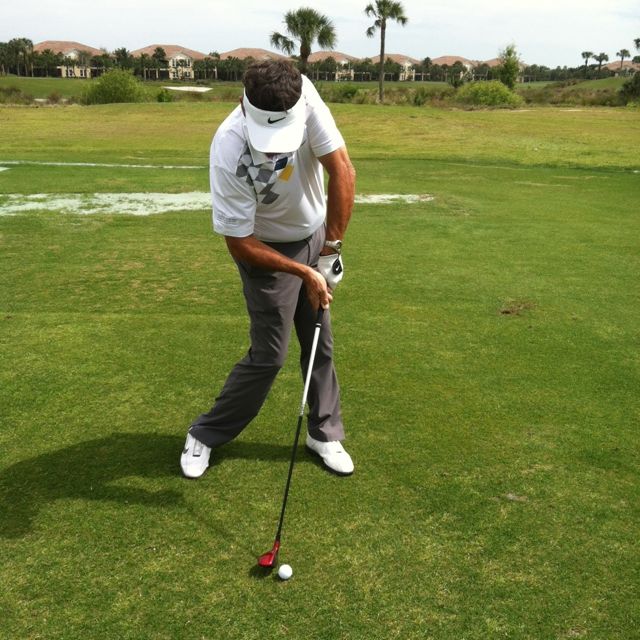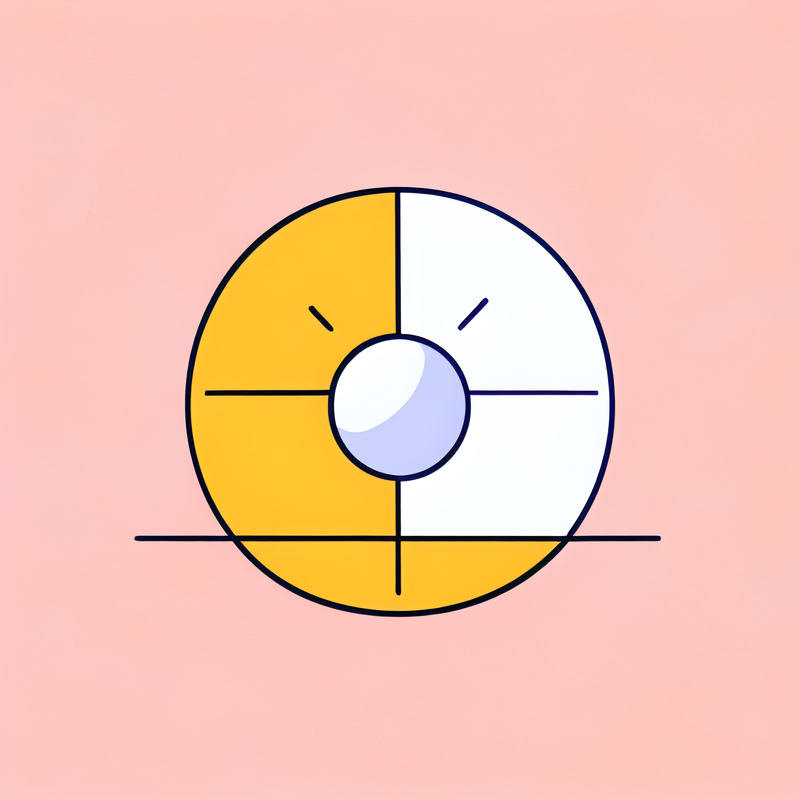Common Causes of Topping the Golf Ball
Topping golf ball can be a frustrating experience for many golfers. This common problem can lead to poor shots and higher scores. To fix this, understanding the root causes is crucial. Here, we pinpoint the typical reasons golfers top the ball and what you can do to address them.

Improper Stance and Alignment
A correct stance is the foundation of a good golf swing. Improper stance and alignment can throw off your balance and timing, leading to a topped ball. Ensure your feet, hips, and shoulders are parallel to the target line. Your weight distribution should be even, and your knees slightly bent.
Incorrect Ball Position
Ball placement affects the point of impact. A ball too far forward in your stance may cause your club to hit its top. Place the ball in the proper position relative to your stance, which varies with the club you’re using. For most irons, the ball should be just left of center.
Early Extension in Swing
Early extension occurs when you stand up too early in the downswing. This changes the path of the clubhead, often leading to a topped shot. To prevent this, focus on maintaining a consistent spine angle and rotating your hips through the shot.
Lack of Clubhead Control
Controlling the clubhead throughout the swing ensures a clean hit. Any loss of control can result in a mis-hit like topping. A firm grip matched with a confident, smooth swing will help you hit the ball squarely. Practice drills that promote clubhead stability to eliminate the habit of topping the golf ball.
Analyzing Your Swing
To correct the issue of topping the golf ball, delving into your swing mechanics is essential. It’s often the subtle, overlooked flaws that cause inconsistencies in your shots.
Importance of Video Replay
Utilizing video replay is a transformative approach to analyzing your swing. Recording your swing from various angles provides a clear, objective view of what’s happening during each phase. Pay attention to key elements: the stance, the swing path, and the moment of impact. Watching in slow motion can reveal if you’re rushing the downswing or lifting up, two common triggers of topping the golf ball.
Working With a Golf Instructor
Guidance from a golf instructor can offer invaluable insights into your swing issues. A skilled instructor will spot errors you might miss and provide corrective measures tailored to your needs. They can help restructure your swing technique to enhance clubhead control and devise drills that specifically address the problems leading to topped shots. Remember, the ultimate goal is to create a reliable, repeatable swing that eliminates the frustrating pattern of topping the golf ball.
Drills to Prevent Topping
Eliminate the frustration of topping the golf ball with focused drills. They target the common errors and help your muscle memory to achieve better contact consistently.
The Tee Drill for Better Contact
This drill aids in achieving the correct height on your clubface at impact. Place a tee in the ground and position it where the ball normally lies. Without using a ball, practice swinging so that your clubhead hits the tee directly. The goal is to clip the tee gently out of the ground, simulating solid contact with the ball.
The Half-Swing Drill for Control
Shorter swings help build control and confidence. Execute half-swings with your focus on keeping the clubhead low to the ground post-impact. This ensures that your club doesn’t rise prematurely and top the ball. Gradually increase the length of your swing as you gain more control.
The Divot Pattern Recognition Drill
Divot patterns are telling. They show whether you’re hitting the ground before or after the ball, crucial in preventing topping. Hit balls while focusing on creating a divot pattern that starts after the ball’s position, indicating a proper downward strike. This promotes ball-first contact.
Equipment Check
Proper equipment is vital when addressing the issue of topping the golf ball. Just as a musician must have a well-tuned instrument, golfers need clubs that fit their swing to make consistent, solid contact.
The Role of Club Fitting in Consistent Strikes
Club fitting is a critical step towards improving your golf game. Custom fitted clubs can drastically change your performance, adjusting to your size, swing speed, and style. During a fitting session, experts measure various aspects of your swing. These include your height, hand size, and swing characteristics. They then recommend clubs with the right length, lie angle, and grip size. Using clubs that are tailored to your personal specifications helps ensure that the clubface meets the ball squarely, reducing the chances of a topped shot.
Choosing the Right Clubs for Your Swing Type
Selecting the correct clubs goes beyond fitting; it involves understanding your swing type. Are your swings fast or slow? Do you have a high or low trajectory? The answers to these questions influence the kind of clubs you should be using. Players with faster swing speeds might benefit from stiffer shafts, while those with slower speeds may find success with more flexible options. Similarly, understanding the loft and clubhead design that complements your natural swing can help you maintain control and avoid topping the ball. Remember, the goal is to create a harmonious match between your clubs and your swing, enabling you to execute consistent, clean strikes time after time.

Mental Approach to the Game
Mastering the mental game is as important as perfecting the physical aspects. The right mindset can significantly improve your playing experience and reduce the occurrence of topping the golf ball.
Overcoming the Fear of Topping
Fear of topping the golf ball can cause tension, leading to errors in your swing. To overcome this fear:
- Practice mindfully and build confidence in your swing.
- Focus on past successes, not the fear of failure.
- Breathe deeply before each shot to relax your muscles and mind.
- Gradually expose yourself to pressure situations during practice.
By addressing the mental block, you’ll create a more relaxed and focused approach to your game, indirectly addressing the physical causes of topping the golf ball.
Positive Visualization Techniques
Visualization is a powerful tool in golf. It trains the brain to enact the ideal swing before you take the shot.
- Close your eyes and imagine a successful swing and ball flight.
- Envision the perfect stance, swing, contact, and follow-through.
- Use mental imagery regularly, both on and off the course.
Applying these positive visualization techniques helps instill a mindset conducive to clean, consistent shots, reducing the likelihood of topping the golf ball.

On-Course Strategies to Avoid Topping
While practicing the right drills and having properly fitted equipment will improve your game, your strategies on the course also play a crucial role in avoiding topped shots.
Course Management Tips
Good course management begins with pre-planning your shots. Study the layout and identify the hazards. Choose clubs that offer control, rather than just distance. When selecting a shot, consider safety over heroism, especially if you struggle with consistency. Play to your strengths, and opt for a shot with which you feel comfortable and confident. Remember, sometimes the smarter play is a shorter one that you can execute well.
In windy conditions, use a punch shot to keep the ball low. This reduces the risk of topping. Also, assess the lie before every shot. On an uphill lie, play the ball slightly more forward in your stance. If the ground is uneven, make sure to adjust your body to be parallel with the slope.
Adapting to Different Lies and Slopes
Every lie and slope demands a different approach. On uphill slopes, your weight should be on your back foot and adjust your shoulders to match the angle of the hill. This creates a better angle for hitting the ball and minimizes the risk of topping.
For downhill lies, do the opposite. Place more weight on the front foot and angle your shoulders with the slope. Keep your swing plane parallel to the ground, even if the ground is not flat. Practice these adjustments in various conditions to gain confidence and maintain control, eventually reducing the chances of topping the golf ball.
Consistency Through Routine
Achieving a consistent golf game hinges on routine. This routine sets the stage for each shot and helps to prevent mistakes like topping the golf ball.
Establishing a Pre-Shot Routine
A pre-shot routine prepares you both physically and mentally for a shot. Here are steps to build one:
- Begin by standing behind the ball to visualize the shot.
- Check the target line and plan your approach.
- Take a practice swing to feel the motion.
- Align your body with the target line.
- Take a deep breath to relax before the swing.
A good pre-shot routine can calm nerves and promote a focused approach.
Importance of Regular Practice
Regular practice ingrains your golf swing into muscle memory. Here are key points:
- Dedicate time to practice consistently, focusing on problem areas.
- Use drills regularly to correct swing issues.
- Improve muscle memory for a natural and confident swing.
- Engage in varied practice, including different lies and conditions.
Regular practice leads to a confident, reliable swing that reduces the chance of topping the golf ball.
